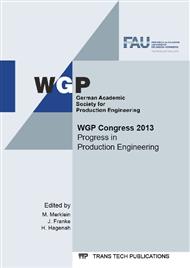p.147
p.157
p.165
p.173
p.181
p.189
p.197
p.205
p.213
Geometrical variations of tubes and their impact on freeform bending processes
Abstract:
In bending processes for tubes and profiles, the produced bending geometry depends on the characteristics of the semifinished product. Tubes are subjected to scatter and deviations from the standard’s dimensions caused by their fabrication process. This results in deviations of the forming behaviour. Depending on the bending process, the effect of this phenomenon is even larger, if the deviation of process forces leads to a significant deflection of the die elements. Particularly kinematic bending processes, e. g. the 3-roll-push-bending process have shown to be highly sensitive to low machine stiffness. The effect of this factor has not been identified among the influences of other disturbance factors so far. As an additional aspect, the tube dimensions affect the material characterization which leads to inaccurate material properties in numerical simulations. This results in wrong input data for the process design and has to be corrected in lengthy adjustment procedures. In this contribution the scatter of some geometrical tubes properties and its impact on the 3-roll-push-bending process is investigated. The tube geometry is measured by a tactile measurement system and is compared to the product standards. Observed deviations are categorized according to DIN 4760. The impact of the deviations on the bending process is examined by numerical variant calculations. Besides the tube dimensions, the stiffness of the machine is varied and the influence determined. By considering the errors resulting from wrong input data in the material characterization the overall error is quantified.
Info:
Periodical:
Pages:
181-188
Citation:
Online since:
September 2013
Authors:
Keywords:
Price:
Сopyright:
© 2013 Trans Tech Publications Ltd. All Rights Reserved
Share:
Citation:


